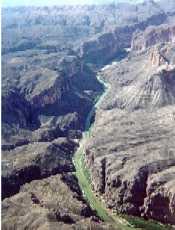
BIOLOGY OF THE RIO GRANDE BORDER REGION:
A BIBLIOGRAPHY

Introduction
The Rio Grande (Río Bravo del Norte) border area evokes images of wilderness; however, the realities of present-day population pressures are rapidly transforming this formerly wild frontier. In 1995, the National Biological Service (now the Biological Resources Division of the U.S. Geological Survey) funded an initiative along the Lower Rio Grande from Elephant Butte Reservoir to the Gulf of Mexico to address the ecosystem-level changes. As part of this effort, we have compiled this bibliography for researchers, resource managers, planners and policy makers to make accessible what is known about the biology of this region. We have concentrated on references to the biotic literature recognizing that works from the physical sciences, as well as historical treatments, may provide additional biological insight.
Several comprehensive bibliographies provided us with a starting point. References from the National Park Service's Big Bend National Park natural resources bibliography, the Texas General Land Office's Rio Grande Coastal Impact Monitoring Program bibliography, and the USGS Biological Resources Division's Biomonitoring of Environmental Status and Trends Program analysis of contaminant impacts in the Lower Rio Grande were particularly helpful. The Fish and Wildlife Reference Service provided many additional references not available through other online sources. Sections of the bibliography were then reviewed by experts in their respective fields, and their suggestions were incorporated. In addition, many individuals, agencies and organizations throughout the country were contacted for their contributions.
The bibliography is organized into 25 subject areas with author and keyword indexes. Coarse taxonomic categories of plants and animals, which predominantly include works on species biology, form the core of the collection. Historical and popular accounts in the Natural History section, as well as citations in the Ecology sections, provide important supportive information. Several smaller sections contain references that are not strictly biological in nature, but which are specific to the region and are significant to the ecosystem as a whole. We have also included two special sections. The first of these, the Overview, is intended to provide a few key references, while the Bibliographies and Directories section points the reader to more diverse and comprehensive collections of references.
This bibliography is in no way intended as a comprehensive listing of references to the biological literature of the Rio Grande border region. For the most part, we tried to include only information that was collected from, or directly pertinent to, the geographic area 100 km north and south of the Rio Grande between Elephant Butte Dam and the Gulf of Mexico. We attempted to include only those references which were complete and, as such, could be obtained through a library or some other information service. Citations generally follow the guidance in Scientific Style and Format: the CBE Manual for Authors, Editors, and Publishers.1(1Where possible, we have provided addresses for obtaining publications that are more difficult to access. For those who identify errors or omissions, we welcome your suggestions and contributions to this continually expanding database. It is our intention that this bibliography will be periodically updated. A current, searchable version of the bibliography database can be found on the Internet home page of the U.S. Geological Survey, Biological Resources Division, Midwest Science Center.
The richness of the literature reflects the diversity of the
natural resources of the Rio Grande. We hope this bibliography will be of value to those
who are interested in preserving and protecting the ecosystems of these borderlands.
We are indebted to those who compiled the bibliographies from which we selected references to form the core of this bibliography: Marilyn Ostergren, Arnold Van Pelt and Kevin McDonough who worked on the Big Bend National Park Natural Resource Bibliography; Don Hockaday, Gayle Robinson and Cheryl Salaiz of the Texas Coastal Impact Monitoring Program; and Miguel Mora and Susan Wainwright of the USGS Biological Resources Division Brazos Field Research Station. We are especially grateful to the experts who took time to review the various sections: David E. Bowles, Texas Parks and Wildlife Department; Robert D. Bradley, Texas Tech University; Tim Brush, University of Texas - Pan American; Mark Flora, National Park Service, Water Resources Division; Gary P. Garrett, Texas Parks and Wildlife Department; Frank Judd, University of Texas - Pan American; Chris Onuf, USGS Biological Resources Division Texas Gulf Coast Field Research Station; A. Michael Powell, Sul Ross State University; Alfred Richardson, University of Texas at Brownsville and Texas Southmost College; and Arnold Van Pelt of Greensboro, North Carolina. Their input significantly strengthened this document.
Richard D. Worthington of the University of Texas at El Paso furnished additional references. Vincent Burke of the Midwest Science Center and David Diamond of the Missouri Resource Assessment Partnership provided valuable advice. Kate Kase of the USGS National Center and Beth Vairin and Susan Lauritzen of the USGS, Biological Resources Division National Wetlands Research Center generously provided assistance in the production. We appreciate the cooperation of the numerous other individuals throughout the nation who contributed their knowledge and expertise to this effort, particularly those in numerous Texas state government offices.
1. Council of Biology Editors, Style Manual Committee. 1994. Scientific style and format: the CBE manual for authors, editors, and publishers. 6th ed. New York: Cambridge University Press. 825 p.




